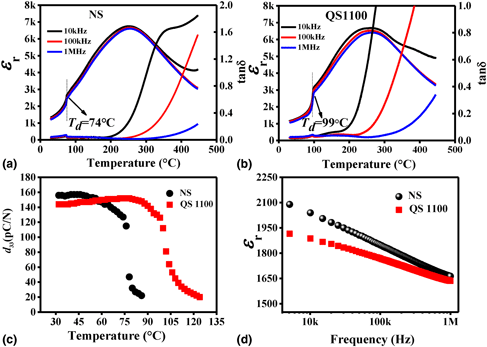Article contents
Effects of defect on thermal stability and photoluminescence in quenched Ho-doped 0.94Na0.5Bi0.5TiO3–0.06BaTiO3 lead-free ceramics
Published online by Cambridge University Press: 05 October 2020
Abstract

Solid solution 0.94Na0.5Bi0.5TiO3–6BaTiO3 (NBT–6BT) is considered to be one kind of lead-free piezoelectric materials with excellent electrical properties due to the existence of morphotropic phase boundary (MPB). However, its relatively lower depolarization temperature is a long-standing bottleneck for the application of NBT-based piezoelectric ceramics. In this work, the influence of thermal quenching on depolarization temperature and electrical properties of rare-earth Ho-doped NBT–6BT lead-free ceramics was investigated. It was shown that the relative high piezoelectric performance, as well as an improvement of depolarization temperature (Td), can be realized by thermal quenching. The results showed that the quenching process induced high concentration of oxygen vacancy, giving rise to the change of octahedra mode and enhanced lattice distortion, which is benefit to the temperature stability of piezoelectric and ferroelectric properties. Furthermore, up-conversion photoluminescence (PL) of Ho-doped NBT–6BT could be effectively tuned by the introduction of oxygen vacancy, suggesting a promising potential in optical–electrical multifunctional devices.
- Type
- Invited Paper
- Information
- Copyright
- Copyright © The Author(s), 2020, published on behalf of Materials Research Society by Cambridge University Press
References
- 6
- Cited by



